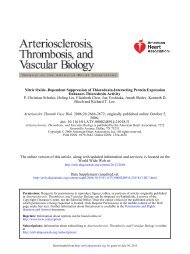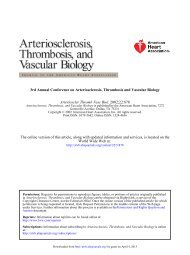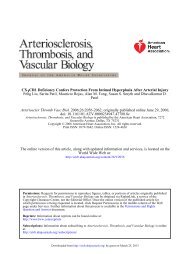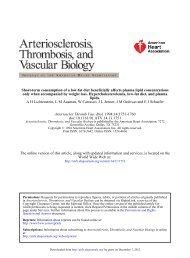Smooth Muscle Cells in Atherosclerosis Originate - Arteriosclerosis ...
Smooth Muscle Cells in Atherosclerosis Originate - Arteriosclerosis ...
Smooth Muscle Cells in Atherosclerosis Originate - Arteriosclerosis ...
Create successful ePaper yourself
Turn your PDF publications into a flip-book with our unique Google optimized e-Paper software.
The f<strong>in</strong>d<strong>in</strong>g of <strong>in</strong>timal SMCs that do not orig<strong>in</strong>ate from the<br />
graft or from hematopoietic stem cells <strong>in</strong> rodent models of<br />
ve<strong>in</strong> graft atherosclerosis and allotransplantation arteriopathy<br />
has led to the theory that circulat<strong>in</strong>g smooth muscle progenitor<br />
cells of nonhematopoietic orig<strong>in</strong> exist and participate <strong>in</strong><br />
vascular lesion formation. 25 It is, however, important to<br />
realize that migration of SMCs from the contiguous vasculature<br />
<strong>in</strong>to the graft <strong>in</strong> those types of studies has not been<br />
conclusively excluded. For <strong>in</strong>stance, Hu et al found that 40%<br />
of SMCs <strong>in</strong> atherosclerotic lesions of ve<strong>in</strong> grafts were not<br />
derived from the local vessel wall or from hematopoietic stem<br />
cells, but the experimental design did not allow to dist<strong>in</strong>guish<br />
between SMCs migrat<strong>in</strong>g through the anastomosis sites and<br />
hom<strong>in</strong>g and differentiation of SMCs from nonhematopoietic<br />
circulat<strong>in</strong>g progenitor cells. 23 If migrat<strong>in</strong>g medial SMCs were<br />
the source of these cells, then the fact that our lesions<br />
developed isolated from the recipient vasculature by a stretch<br />
of unaffected donor vessel (Figure 6a), whereas lesions <strong>in</strong> the<br />
ve<strong>in</strong> graft model did not, may expla<strong>in</strong> the differences <strong>in</strong> the<br />
result obta<strong>in</strong>ed. Another explanation could be the <strong>in</strong>herent<br />
differences between SMCs of arterial and venous orig<strong>in</strong>. 26<br />
Local Source of Plaque SMCs<br />
Our experiments were not designed to discrim<strong>in</strong>ate between<br />
candidate sources for plaque SMCs with<strong>in</strong> the vascular wall.<br />
Bentzon et al Orig<strong>in</strong> of SMCs <strong>in</strong> <strong>Atherosclerosis</strong> <strong>in</strong> ApoE / Mice 2701<br />
Downloaded from<br />
http://atvb.ahajournals.org/ by guest on June 4, 2013<br />
Figure 6. Analysis of atherosclerotic<br />
plaques <strong>in</strong>duced <strong>in</strong> surgically transferred<br />
CCA segments demonstrated that<br />
plaque SMC are derived from the local<br />
arterial wall. a-c, All SMA cells were<br />
eGFP - <strong>in</strong> plaques develop<strong>in</strong>g <strong>in</strong> apoE /<br />
CCA segments grafted <strong>in</strong>to<br />
eGFP apoE / mice. The eGFP signal<br />
visible <strong>in</strong> the top left corner of a is an<br />
artifact caused by diffusion <strong>in</strong>to the outer<br />
medial layer of perivascular extracellular<br />
eGFP, which was abundantly present<br />
around transplanted vessels <strong>in</strong><br />
eGFP apoE / mice. Red <strong>in</strong>dicates<br />
SMA; green, eGFP; blue, DAPI; grayscale,<br />
DIC; L, lumen; C, fibrous cap; F,<br />
foam cells; M, tunica media. Scale<br />
bar25 m. d-e, Conversely, <strong>in</strong> plaques<br />
<strong>in</strong>duced <strong>in</strong> eGFP apoE / CCA segments<br />
grafted <strong>in</strong>to apoE / mice, virtually<br />
all SMA cells were eGFP . L <strong>in</strong>dicates<br />
lumen; C, fibrous cap; NC, necrotic core;<br />
F, foam cells; M, tunica media. Scale<br />
bar25 m.<br />
Several alternatives to vascular SMCs have been proposed,<br />
<strong>in</strong>clud<strong>in</strong>g endothelial-to-SMC differentiation and <strong>in</strong>vasion of<br />
fibroblasts or stem cell progeny from the tunica adventitia.<br />
27,28 However, the identification of the local arterial wall as<br />
the orig<strong>in</strong> of plaque SMCs established <strong>in</strong> this study comb<strong>in</strong>ed<br />
with the observation of Feil et al that a major fraction of<br />
plaque SMCs orig<strong>in</strong>ate from SM22 cells, 6 p<strong>in</strong>po<strong>in</strong>t that <strong>in</strong><br />
mice—that have no resident <strong>in</strong>timal SMCs—tunica media is<br />
the major contributor to SMCs <strong>in</strong> atherosclerotic plaques.<br />
Conclusions<br />
Our experiments demonstrate that atherosclerotic plaque<br />
SMCs are derived exclusively from the local vessel wall <strong>in</strong><br />
apoE / mice. This observation strongly supports the orig<strong>in</strong>al<br />
hypothesis that these cells orig<strong>in</strong>ate from local vascular<br />
SMCs and disagrees with the proposed role of circulat<strong>in</strong>g<br />
smooth muscle progenitor cells <strong>in</strong> atherogenesis. These f<strong>in</strong>d<strong>in</strong>gs<br />
have implications for future research <strong>in</strong>to the mechanisms<br />
by which the fibrous component of atherosclerosis<br />
develops.<br />
Acknowledgments<br />
We thank Sandra H. van He<strong>in</strong><strong>in</strong>gen and Erik Biessen for <strong>in</strong>structions<br />
on the constrictive collar model, and Helle Quist, Birgitte Sahl, and<br />
Merete Dixen for excellent technical assistance.














